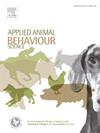人类的存在对奶牛的社会缓冲作用
IF 2.2
2区 农林科学
Q1 AGRICULTURE, DAIRY & ANIMAL SCIENCE
引用次数: 0
摘要
这项研究调查了一个不熟悉的人的存在是否可以减轻奶牛的压力反应,作为社会缓冲。采用隔离模式对10头泌乳意大利红斑牛的行为和生理应激指标进行了评估。测试了两种条件:隔离(奶牛单独)和社会(奶牛有人类在场)。通过行为学观察行为反应,并通过每次测试前后的血浆皮质醇浓度测量压力水平。我们将15分钟的测试分成30个连续的30秒的箱子,每个行为变量产生30个时间序列点。数据分析使用伽马分布glmm,条件和Condition×Interval为固定效应,受试者ID为随机截距。在每个条件下运行单独的模型来评估与时间相关的趋势。孤立状态下的压力相关行为高于社会状态下的压力相关行为,两者的时间波动不同,但没有一致的线性趋势。孤立状态下运动能力较高;随着时间的推移,这两种情况都表现出显著的线性下降,尽管速度不同。与人类的亲近程度总体上没有差异,但只有在社会条件下随时间线性增加。勘探无条件效应;社交方面下降明显,孤立方面略有下降。站立既无状态差异,也无线性时间趋势。陌生人引导的行为,只记录在《社交》杂志上,随着时间的推移呈线性增长。仅在隔离条件下观察到皮质醇水平的显著增加。总的来说,数据表明人类的存在可以减轻奶牛遭受隔离压力的压力。这项研究在改善农业系统中的动物福利和生产力方面具有实际应用价值,例如通过减少与压力相关的行为和提高动物应对挑战情况的能力。本文章由计算机程序翻译,如有差异,请以英文原文为准。
The role of human presence as social buffer for dairy cattle
This study investigates whether the presence of an unfamiliar human can alleviate stress responses in cows, acting as a social buffer. We assessed behavioral and physiological stress indicators in ten lactating Italian Red Pied cows using the isolation paradigm. Two conditions were tested: Isolation (cow alone) and Social (cow with a human present). Behavioral responses were observed ethologically, and stress levels were also measured via plasma cortisol concentrations before and after each test. We divided the 15-minute test into 30 consecutive 30-second bins, yielding 30 time-series points per behavioral variable. Data were analyzed using Gamma-distributed GLMMs with Condition and Condition×Interval as fixed effects and Subject ID as a random intercept. Separate models were run within each condition to assess time-related trends. Stress-related behaviors were higher under Isolation than Social conditions, with differing temporal fluctuations but no consistent linear trend in either condition. Locomotion was higher in Isolation; both conditions exhibited a significant linear decrease over time, though at different rates. Proximity to human did not differ overall but increased linearly over time only in the Social condition. Exploration showed no condition effect; it declined significantly in Social and marginally in Isolation. Standing showed neither condition differences nor linear time trends. Stranger-directed behaviors, recorded only in Social, increased linearly over time. A significant increase in cortisol levels was observed only in the Isolation condition. Overall, the data suggest that human presence can reduce stress in cows subjected to isolation stress. This study has practical applications for improving animal welfare and productivity in farming systems, for example by reducing stress-related behaviors and enhancing animals’ ability to cope with challenging situations.
求助全文
通过发布文献求助,成功后即可免费获取论文全文。
去求助
来源期刊

Applied Animal Behaviour Science
农林科学-行为科学
CiteScore
4.40
自引率
21.70%
发文量
191
审稿时长
18.1 weeks
期刊介绍:
This journal publishes relevant information on the behaviour of domesticated and utilized animals.
Topics covered include:
-Behaviour of farm, zoo and laboratory animals in relation to animal management and welfare
-Behaviour of companion animals in relation to behavioural problems, for example, in relation to the training of dogs for different purposes, in relation to behavioural problems
-Studies of the behaviour of wild animals when these studies are relevant from an applied perspective, for example in relation to wildlife management, pest management or nature conservation
-Methodological studies within relevant fields
The principal subjects are farm, companion and laboratory animals, including, of course, poultry. The journal also deals with the following animal subjects:
-Those involved in any farming system, e.g. deer, rabbits and fur-bearing animals
-Those in ANY form of confinement, e.g. zoos, safari parks and other forms of display
-Feral animals, and any animal species which impinge on farming operations, e.g. as causes of loss or damage
-Species used for hunting, recreation etc. may also be considered as acceptable subjects in some instances
-Laboratory animals, if the material relates to their behavioural requirements
 求助内容:
求助内容: 应助结果提醒方式:
应助结果提醒方式:


